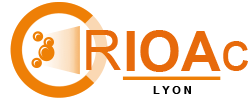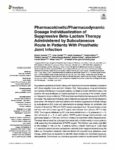Pharmacokinetic/Pharmacodynamic Dosage Individualization of Suppressive Beta-Lactam Therapy Administered by Subcutaneous Route in Patients With Prosthetic Joint Infection
Suppressive parenteral antibiotic therapy with beta-lactams may be necessary in patients with Gram-negative bone and joint infection (BJI). Subcutaneous drug administration can facilitate this therapy in outpatient setting, but there is limited information about this practice. We have developed an original approach for drug dosing in this context, based on therapeutic drug monitoring (TDM) and pharmacokinetic/pharmacodynamic (PK/PD) principles. The objective of this study was to describe our approach and its first results in a case series. We analyzed data from patients who received suppressive antibiotic therapy by subcutaneous (SC) route with beta-lactams as salvage therapy for prosthetic joint infection (PJI) and had TDM with PK/PD-based dose adjustment. Ten patients (six women and four men with a mean age of 77 years) were included from January 2017 to May 2020. The drugs administered by SC route were ceftazidime (n = 4), ertapenem (n = 4), and ceftriaxone (n = 2). In each patient, PK/PD-guided dosage individualization was performed based on TDM and minimum inhibitory concentration (MIC) measurements. The dose interval could be prolonged from twice daily to thrice weekly in some patients, while preserving the achievement of PK/PD targets. The infection was totally controlled by the strategy in nine out the 10 patients during a median follow-up of 1,035 days (~3 years). No patient acquired carbapenem-resistant Gram-negative bacteria during the follow-up. One patient presented treatment failure with acquired drug resistance under therapy, which could be explained by late MIC determination and insufficient exposure, retrospectively. To conclude, our innovative approach, based on model-based TDM, MIC determination, and individualized PK/PD goals, facilitates, and optimizes suppressive outpatient beta-lactam therapy administered by SC route for PJI. These encouraging results advocate for larger clinical evaluation.



